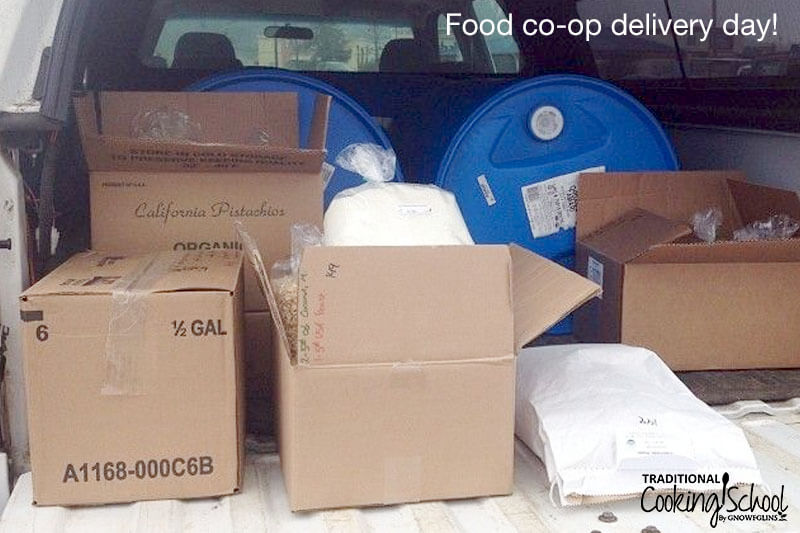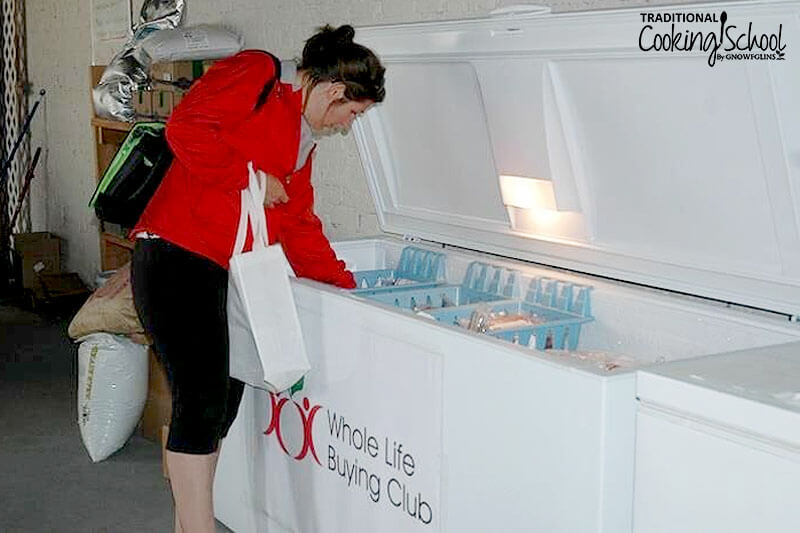
We only recommend products and services we wholeheartedly endorse. This post may contain special links through which we earn a small commission if you make a purchase (though your price is the same).

Looking for a great source of high-quality food? Consider joining a community food co-op! Here’s everything you need to know about them — what they are and how to find one in your area.

When we began eating traditional foods, locating good sources of high-quality ingredients was very challenging…
I found it hard to wrap my head around it all. I was used to getting everything I needed at the grocery store and didn’t even know where to start to find better sources.
Many blogs and books I read discussed community food co-ops, which I had never heard of before, much less knew how to go about finding one.
Do you have the same questions? Let’s get them answered today!
Table Of Contents
Food co-ops, or food cooperatives, are groups of people or workers that buy food together.
There are food co-ops for overstocked or bulk items at steep discounts, traditional grocery store items — as well as organic and natural foods. This post focuses on organic and natural food co-ops.
Some food co-ops are very simple and can be a large or small group of people within a community that place orders together. This is usually done in to receive bulk discount savings and may also be referred to as a buying club.
In some locations, food co-ops have a physical building and are more like food distribution outlets. These may be warehouse-type buildings where food is stored and picked up.
Some are grocery stores that are owned by a community of members.
I once participated in a local, member-led food co-op that was like a mini health food store.
Anyone could shop there, but we also had the option to pay a yearly fee and take part in “ownership.” Owners received further discounts as well as voting rights regarding operations.
Many food co-ops focus on procuring healthy food at a discounted rate. Others are a resource for buying local, organically grown meats and produce that may not otherwise be readily available.
Both options are beneficial depending on your needs.

Each co-op has their own policies and practices vary from group to group.
Generally speaking, if you are part of a co-op that is not “grocery store-style,” you place an order (usually online). You may pick up the order directly from the co-op, or it is delivered to your house or somewhere near you.
Often there are drop offs at one co-op member’s home and others nearby pick up their orders from the hosting house.
You can find out the address of your pickup location usually when you place your first order, but it may be possible to find the general location out beforehand, or you can sign up to be a host home yourself!
Many of these online group co-ops have accompanying Facebook groups or email messaging in order to communicate co-ops deadlines, pick ups, and so on.
Some food co-ops require a small fee to join, while others are free.
Many community food co-ops are run by volunteers, while others (usually grocery store-style co-ops) have paid employees.
Grocery store-style community food co-ops generally have a board of directors. Members of the co-op are also provide input on operations and the type of products carried in the store.
Most organic and natural food co-ops have specific criteria a food or product must meet in order to be available for order. This criteria will vary, but often has to do with the ingredients and sometimes the manufacturing practices as well.

A community food co-op can help you save money and access healthy food options that may not otherwise be available in your area.
Many following special diets (such as GAPS, Trim Healthy Mama, gluten-free, and so on) find food co-ops helpful in purchasing compliant items that can be difficult to find in regular grocery stores.
Food co-ops are also a great way to discover new foods and resources you may not currently be unaware of. You may find these by browsing the store shelves, online catalog, or hearing about them from other members.
One side benefit of joining a food co-op is that if it often an opportunity to forge new friendships. If you’re passionate about good food, you’ll find others who feel the same within the co-op!
You may discover other similar interests among co-ops members, as well as folks with unique knowledge they are willing to share (such as traditional cooking skills!).
Some food co-ops also host classes and educational events on a variety of topics.
Besides the personal benefits, food co-ops also help support companies that are making healthy food and natural products. This is one way you can vote with your dollars!
In most situations the answer is yes! Although this really depends on what other resources are available in your area.
In general, if you want to eat healthy on a budget, a food co-ops can help! Large families, couples, and singles alike find this an excellent option.
Food co-ops save money by ordering in bulk. Many are able to order at wholesale prices and cut out the middleman.
That said, it is helpful to keep an eye on your co-op’s prices. While food co-ops often have prices that are exceptionally lower, especially when purchased in bulk, not all items may be a great deal.
At least for my co-op, produce and meat are much more expensive than the health food store or farmer’s market. While I could order items we use a lot of like Bragg’s Apple Cider Vinegar or Real Salt at our co-op, I have found better prices nearby at our local health food store or Amazon.
The beans, grains, and baking supplies, however, are significantly cheaper through the co-op, where I might get a 20 or 50 pound bag.
It really depends on the co-op!
Need food? There’s a co-op for that! 🙂
I use mine for organic and sustainable dried beans, grains, and baking supplies. Spices we use in large quantities, like cinnamon and ginger, are a great deal too.

Meat, dairy products, and even “healthy” convenience foods can be found in a co-op.
Keep in mind that co-ops often have a minimum amount you need to spend per order. This can often influence your purchases.
I don’t place an order every month because I buy such large quantities. When I do place an order, meeting the minimum amount is usually not a problem.
Household items such as non-toxic cleaning supplies, kitchen supplies (like parchment paper), glass jars, and personal care products are often available too.
There are a number of ways to find a community food co-op. Here are a few suggestions:
Azure Standard has drop locations throughout the United States, with the exception of the northeastern states (at the time of writing).
Search for “organic food co-op” online and you may be able to find one in your city or region.
I recommend using Local Harvest and searching for a co-op by your city or zip code on their website. If you do have trouble locating one, increase your search to your entire state (or even nearby states if you’re near a border).
Before you start thinking that you can’t drive hours every month to pick up a co-op order, hear me out…
Search terms don’t always show the delivery distance range, just where the headquarters are. So if you broaden your search results, you may find a drop location nearby, even though the co-op itself is farther away!
It takes time to make phone calls, but finding items raised and grown with healthy practices is worth the effort.
Another option is to ask around in your community.
Use social media, if you have it, or ask in person. Your friends may not know, but perhaps they have a friend or acquaintance who does.
If there are any food or health-related groups in your area, they may be a great resources. I also found my homeschool group very helpful in locating various healthy and frugal food sources.
Finally, here are a few other articles to check out!
The best food co-op is different for everyone. It really depends on your needs.
It can take some time to find the right fit and you may need to participate in more than one.
If saving money is important to you, the co-op with the lowest prices might be the best. But if you highly value community relationships and education, a co-op with a vibrant, active membership may be the best option for you.
Try a few and see what you think. That’s the best way to find the co-op that is most suitable.
If you can’t find a co-op in your community or there isn’t one that suits your needs, consider starting your own.
For detailed information and step-by-step instructions on how to start your own food co-op, check out these articles:
Do you use a community food co-op to purchase items? What do you like to buy at yours?
This post was originally published and written by Jenny Cutler in December 2013. It was updated and republished on 3/16/20.
. without giving up the foods you love or spending all day in the kitchen!